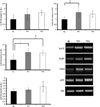Acute exercise activates p38 MAPK and increases the expression of telomere-protective genes in cardiac muscle
- PMID: 28166612
- PMCID: PMC5378631
- DOI: 10.1113/EP086189
Acute exercise activates p38 MAPK and increases the expression of telomere-protective genes in cardiac muscle
Abstract
What is the central question of this study? A positive association between telomere length and exercise training has been shown in cardiac tissue of mice. It is currently unknown how each bout of exercise influences telomere-length-regulating proteins. We sought to determine how a bout of exercise altered the expression of telomere-length-regulating genes and a related signalling pathway in cardiac tissue of mice. What is the main finding and its importance? Acute exercise altered the expression of telomere-length-regulating genes in cardiac tissue and might be related to altered mitogen-activated protein kinase signalling. These findings are important in understanding how exercise provides a cardioprotective phenotype with ageing. Age is the greatest risk factor for cardiovascular disease. Telomere length is shorter in the hearts of aged mice compared with young mice, and short telomere length has been associated with an increased risk of cardiovascular disease. One year of voluntary wheel-running exercise attenuates the age-associated loss of telomere length and results in altered gene expression of telomere-length-maintaining and genome-stabilizing proteins in heart tissue of mice. Understanding the early adaptive response of the heart to an endurance exercise bout is paramount to understanding the impact of endurance exercise on heart tissue and cells. To this end, we studied mice before (BL), immediately after (TP1) and 1 h after a treadmill running bout (TP2). We measured the changes in expression of telomere-related genes (shelterin components), DNA-damage-sensing (p53 and Chk2) and DNA-repair genes (Ku70 and Ku80) and mitogen-activated protein kinase (MAPK) signalling. The TP1 animals had increased TRF1 and TRF2 protein and mRNA levels, greater expression of DNA-repair and -response genes (Chk2 and Ku80) and greater protein content of phosphorylated p38 MAPK compared with both BL and TP2 animals. These data provide insights into how physiological stressors remodel the heart tissue and how an early adaptive response mediated by exercise may be maintaining telomere length and/or stabilizing the heart genome through the upregulation of telomere-protective genes.
Keywords: gene expression; telomerase; telomere.
© 2017 The Authors. Experimental Physiology © 2017 The Physiological Society.
Figures





Similar articles
-
Exercise alters mRNA expression of telomere-repeat binding factor 1 in skeletal muscle via p38 MAPK.J Appl Physiol (1985). 2012 Dec 1;113(11):1737-46. doi: 10.1152/japplphysiol.00200.2012. Epub 2012 Oct 4. J Appl Physiol (1985). 2012. PMID: 23042912 Free PMC article.
-
Effects of physical exercise on myocardial telomere-regulating proteins, survival pathways, and apoptosis.J Am Coll Cardiol. 2008 Aug 5;52(6):470-82. doi: 10.1016/j.jacc.2008.04.034. J Am Coll Cardiol. 2008. PMID: 18672169
-
Training Performed Above Lactate Threshold Decreases p53 and Shelterin Expression in Mice.Int J Sports Med. 2018 Sep;39(9):704-711. doi: 10.1055/a-0631-3441. Epub 2018 Jun 26. Int J Sports Med. 2018. PMID: 29945271
-
The role of p38 MAPK pathway in p53 compromised state and telomere mediated DNA damage response.Mutat Res Genet Toxicol Environ Mutagen. 2018 Dec;836(Pt A):89-97. doi: 10.1016/j.mrgentox.2018.05.018. Epub 2018 May 26. Mutat Res Genet Toxicol Environ Mutagen. 2018. PMID: 30389168 Review.
-
DNA repair factors and telomere-chromosome integrity in mammalian cells.Cytogenet Genome Res. 2004;104(1-4):116-22. doi: 10.1159/000077475. Cytogenet Genome Res. 2004. PMID: 15162024 Review.
Cited by
-
Notch1 Is Involved in Physiologic Cardiac Hypertrophy of Mice via the p38 Signaling Pathway after Voluntary Running.Int J Mol Sci. 2023 Feb 6;24(4):3212. doi: 10.3390/ijms24043212. Int J Mol Sci. 2023. PMID: 36834623 Free PMC article.
-
Effect of aging and exercise on hTERT expression in thymus tissue of hTERT transgenic bacterial artificial chromosome mice.Geroscience. 2025 Jun;47(3):3325-3341. doi: 10.1007/s11357-024-01319-5. Epub 2024 Sep 2. Geroscience. 2025. PMID: 39222198 Free PMC article.
-
Telomere length in leucocytes and solid tissues of young and aged rats.Aging (Albany NY). 2022 Feb 27;14(4):1713-1728. doi: 10.18632/aging.203922. Epub 2022 Feb 27. Aging (Albany NY). 2022. PMID: 35220278 Free PMC article.
-
MAP Kinase Phosphatase-5 Deficiency Improves Endurance Exercise Capacity.Cells. 2025 Mar 11;14(6):410. doi: 10.3390/cells14060410. Cells. 2025. PMID: 40136658 Free PMC article.
-
Is There an Exercise-Intensity Threshold Capable of Avoiding the Leaky Gut?Front Nutr. 2021 Mar 8;8:627289. doi: 10.3389/fnut.2021.627289. eCollection 2021. Front Nutr. 2021. PMID: 33763441 Free PMC article. Review.
References
-
- Armstrong L, Lako M, Lincoln J, Cairns PM, Hole N. mTert expression correlates with telomerase activity during the differentiation of murine embryonic stem cells. Mechanisms of Development. 2000;97:109–116. - PubMed
-
- Balady GJBK, Golding LA, Gordon NF, Mahler DA, Myers JN, Sheldahl, Lois M. American College of Sports Medicine: ACSM's Guidelines for Exercise Testing and Prescription. Philadephia: Lippincott, Williams and Wilkins; 2000.
-
- Bar C, Bernardes de Jesus B, Serrano R, Tejera A, Ayuso E, Jimenez V, Formentini I, Bobadilla M, Mizrahi J, de Martino A, Gomez G, Pisano D, Mulero F, Wollert KC, Bosch F, Blasco MA. Telomerase expression confers cardioprotection in the adult mouse heart after acute myocardial infarction. Nat Commun. 2014;5:5863. - PMC - PubMed
-
- Bergmann O, Zdunek S, Felker A, Salehpour M, Alkass K, Bernard S, Sjostrom SL, Szewczykowska M, Jackowska T, Dos Remedios C, Malm T, Andra M, Jashari R, Nyengaard JR, Possnert G, Jovinge S, Druid H, Frisen J. Dynamics of Cell Generation and Turnover in the Human Heart. Cell. 2015;161:1566–1575. - PubMed
Publication types
MeSH terms
Substances
Grants and funding
LinkOut - more resources
Full Text Sources
Other Literature Sources
Research Materials
Miscellaneous

